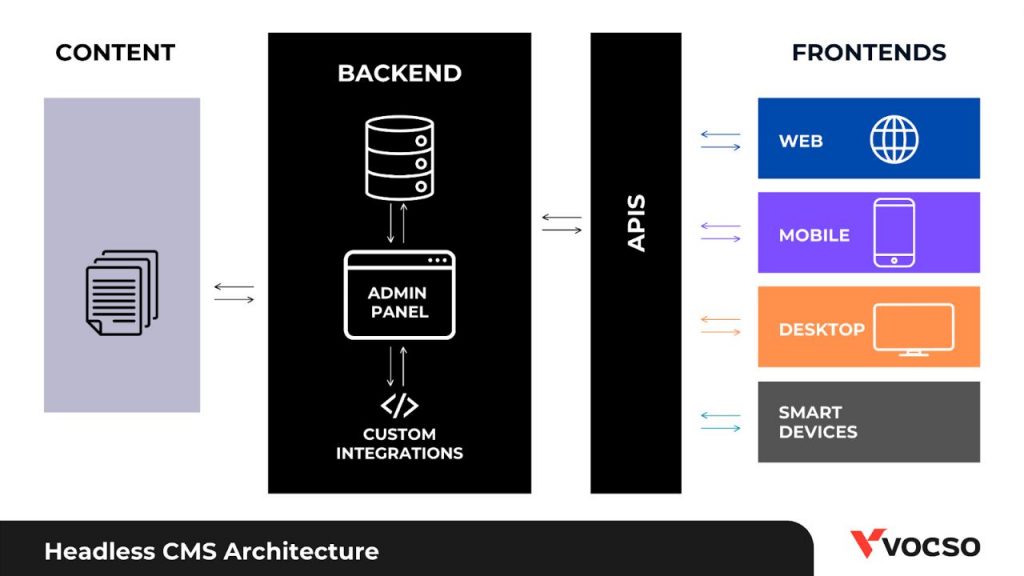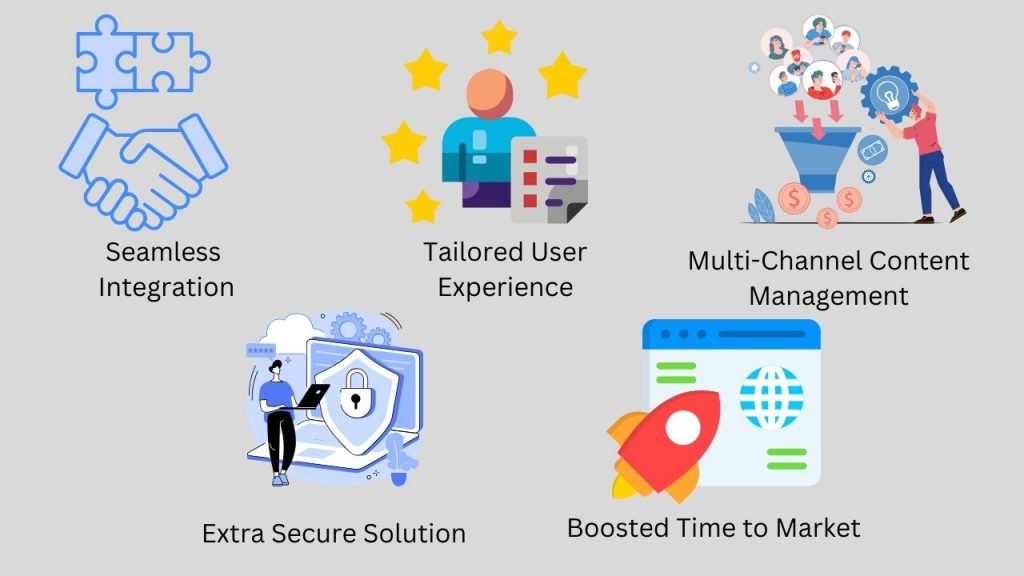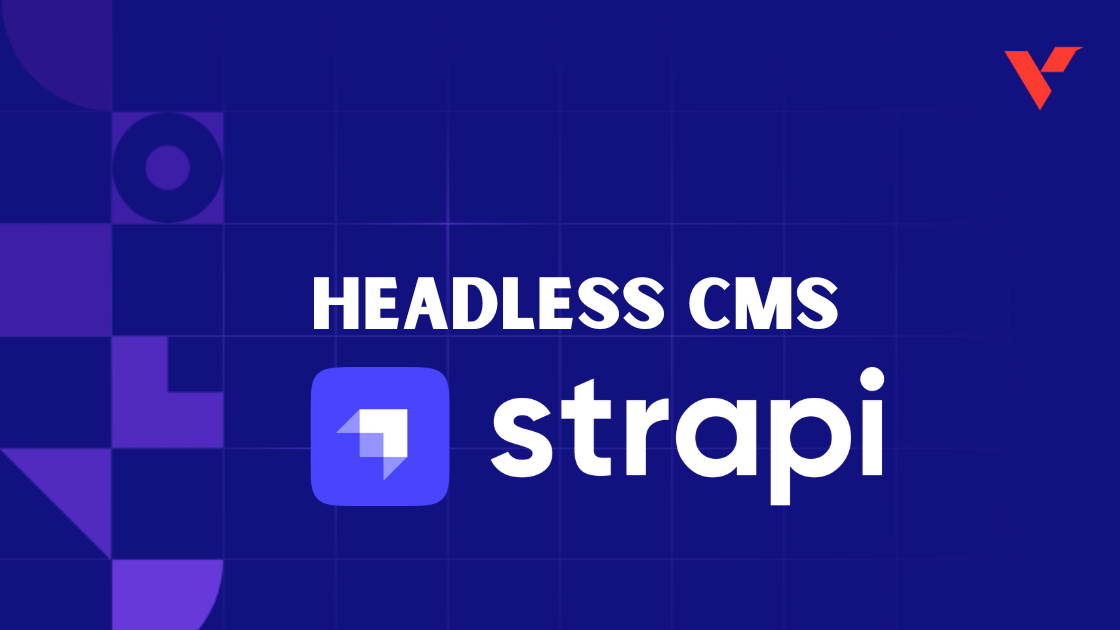Popular Tools by VOCSO
The content management system or CMS makes life easier as we all know of WordPress. The new fuel of today’s world is data. This article will explain why you should opt for the Strapi headless CMS for your next modern web application.
Table of Contents
1. What exactly is a Headless CMS?

Headless CMS is getting popular in place of the traditional CMS. A headless CMS means the back-end content management system is separate from the front-end presentation layer(the back end without any fixed front end).
An entire back-end web content management system that serves as a content repository is a headless content management system that detaches itself from a front-end or presentation layer but makes content available via an API for display on any device.
Headless CMS allows you to manage content in one place and be able to deploy that content on any digital channel you choose e.g. web, mobile app, desktop applications, or even IOT devices. Here we’re discussing one of the most popular open source Headless CMS which is seeing massive adaptation by big brands: Strapi.
Here’s a comparison of various Headless CMS platforms e.g. Strapi, Ghost CMS, KeystoneJS, Directus, and Caisy:
| Feature | Strapi | Ghost CMS | KeystoneJS | Directus | Caisy |
|---|---|---|---|---|---|
| Type | Open-source headless CMS | Open-source headless CMS | Open-source headless CMS | Open-source headless CMS | SaaS headless CMS |
| Primary Language | JavaScript (Node.js) | JavaScript (Node.js) | JavaScript (Node.js) | JavaScript (Node.js) | JavaScript (React-based) |
| Content Model | Flexible, customizable | Primarily for blogging | Schema-based, extensible | Database-first, flexible schema | Schema-based, collaborative |
| Database Support | SQL & NoSQL (SQLite, MongoDB, etc.) | MySQL, SQLite, PostgreSQL | SQL (PostgreSQL, MySQL, SQLite) | SQL (MySQL, PostgreSQL, SQLite) | Hosted, uses own backend |
| Admin Interface | User-friendly, drag-and-drop builder | Simple, minimal | Customizable, Keystone Admin UI | Intuitive, data-centric | Modern, real-time collaboration |
| Customization | Highly customizable, plugins system | Limited customization | Highly customizable | Customizable with extensions | Customizable, collaborative workflows |
| API | REST & GraphQL | REST | REST & GraphQL | REST & GraphQL | GraphQL |
| Extensibility | Plugins, middleware | Limited | Plugins, middleware | Extensions, hooks | Extensions, custom fields |
| Authentication | Built-in, JWT, OAuth | Built-in | Customizable | Built-in, OAuth, SSO | Built-in, SSO |
| Community & Support | Large, active community | Large, active community | Growing community | Growing community | Growing community, support plans |
| Use Case | Any type of content-driven application | Blogging, newsletters | Custom applications, e-commerce | Data-driven applications, IoT | Collaborative content management |
| Deployment | Self-hosted | Self-hosted | Self-hosted | Self-hosted | SaaS |
2. Strapi’s Key Features, that Make it stand out

Strapi boasts an array of features tailored to meet the diverse needs of applications. With its headless architecture, Strapi seamlessly separates backend content management from frontend presentation, ensuring flexibility in application development. Developers can effortlessly define custom content types and leverage RESTful and GraphQL APIs for data manipulation.
Robust role-based access control and authentication mechanisms ensure secure content management. Strapi’s plugin system facilitates extensibility, enabling the integration of custom and community-built plugins to enhance functionality.
Additionally, Strapi’s enterprise-ready nature is underscored by its support for various databases, scalability, and performance optimization features.
Its ORM layer simplifies database interactions, while data relationships and validation mechanisms ensure data integrity. With Strapi’s commitment to simplicity, customization, and scalability, developers can build powerful, tailored applications to suit a myriad of use cases.
| Feature | Description |
| Open-source | Strapi is an open-source platform, that allows developers to view, modify, and contribute to its source code. It allows you to either host it on their cloud or self-host on your server giving you total control. |
| Headless Architecture | Strapi follows a headless CMS architecture, separating the content management backend from the frontend presentation. |
| Custom Content Types | Easily define custom content types and fields using a visual interface or by writing code. |
| RESTful & GraphQL APIs | Automatically generates RESTful and GraphQL APIs for content types, providing flexible options for data manipulation. |
| Role-Based Access Control (RBAC) | Offers a robust role-based access control system for defining granular permissions for users and roles. |
| User Authentication & Authorization | Provides built-in authentication and authorization features, supporting various authentication providers like JWT. |
| Plugins and Extensions | Allows for extending its core functionality with custom plugins or installing community-built plugins from the marketplace. We love this because it allows us to create new functionalities to fulfill our project-specific needs and we don’t have to force clients to use only off-the-shelf features. |
| Content Internationalization (i18n) | Supports managing content in multiple languages within the same project, facilitating multilingual applications. |
| Webhooks and Events System | Trigger custom actions or integrate with external services based on events such as content creation or deletion. |
| Media Management | Features for managing media files such as images, videos, and documents, including upload, storage, and manipulation. |
| Customization for Experienced Developers | Our developers can leverage Strapi’s customization possibilities for performance, security, and deep config dives. |
| Enterprise Ready | Strapi is equipped with features and capabilities to meet the demands of enterprise-level applications, ensuring scalability, security, and support. |
| Flexible Database Support | Strapi supports a variety of databases including MongoDB, PostgreSQL, SQLite, and MySQL, providing flexibility in database choice based on project requirements. |
| Scalability | Designed to scale horizontally to handle increasing loads, making it suitable for applications with growing user bases and content volumes. |
| Performance Optimization | Offers optimization features such as caching, indexing, and query optimization to improve database performance and application responsiveness. |
3. Why should you choose Strapi Headless CMS?
Freedom to choose the tools and frameworks for the front-end: The choice of the front-end tools for the best user experience is now a lot easier with the Strapi CMS. The look and feel are very easy to manage by using better choices on the frontend side. It can be any front-end libraries or full-fledged frameworks.
User-friendly interface for content editors: For content editors, the key to efficiency and productivity lies in a user-friendly interface. Even non-technical users can easily explore the UI for managing database entries. A clean and uncluttered layout simplicity makes it possible to not let any complex UI jargon create productivity issues.
Horizontal Scalability: Strapi is designed to scale horizontally, making it suitable for projects of all sizes, from small websites to large-scale enterprise applications.
Flexible Content Type Builder: There are dozens of fields accessible in the Content-Type structure, so you can mix and match them to suit your needs. Strapi offers a flexible Content-Type Builder empowering users to create custom content models with dozens of field types – text, images, rich text editors, and more – at their disposal making this granular control allowing the control for building content structures that perfectly match specific needs, whether it’s managing a simple blog or a complex e-commerce product catalog with intricate variations.
Performance: With features like caching, indexing, and query optimization, Strapi helps optimize performance, ensuring fast response times and efficient resource utilization.
Integration Capabilities: Strapi’s API-first approach enables seamless integration with third-party services, tools, and platforms, empowering clients to extend their website’s functionality and enhance the overall user experience.
Future-proofing: By choosing Strapi, you future-proof your websites/apps, as the platform continuously evolves with regular updates, improvements, and new features, ensuring long-term relevance and competitiveness.
4. The Strapi benefits over other Headless CMS:

Strapi stands out as the go-to choice for developers seeking an exceptional developer experience and rapid development approach in the MEAN STACK (NodeJS, Reactjs/NextJS ) ecosystem. With customizable GraphQL and REST APIs, teams can effortlessly tailor solutions to their specific needs, fostering efficiency and innovation.
Whether Strapi should be your choice of CMS for your project, depends on several factors. I’ve tried to provide a clear comparison between Strapi and other popular CMS options such as WordPress, Webflow, Wix, Contentful, and Sanity. This will give a direction to your decision, if you’re still unsure, reach out to our consultants to guide you through.
| Feature | Strapi | WordPress | Webflow | Wix | Contentful | Sanity |
| Flexibility | ✔️ | Limited by monolithic architecture | Drag-and-drop with limited backend customization | Drag-and-drop with limited backend customization | ✔️ | ✔️ |
| Customization | ✔️ Custom content types, plugins | Themes and plugins, coding required | Design customization for frontend | Templates and widgets | ✔️ Flexible content structures | ✔️ Complex data structures |
| Cost-effectiveness | ✔️ Open-source + cloud hosted options | ✔️ Free core, costs for hosting, themes | Pricing plans with limitations | Pricing plans with limitations | Subscription-based, scalable | Subscription-based, scalable |
| Ease of Use | ✔️ Intuitive UI, visual builder | User-friendly, learning curve | Visual editor with backend knowledge | Drag-and-drop website creation | ✔️ User-friendly, intuitive | ✔️ User-friendly, intuitive |
| Scalability | ✔️ Horizontal scaling for any size project | Hosting-dependent, suited for medium | Scalable, may have limitations | Cloud-based with scalability | ✔️ Scalable with CDN support | ✔️ Scalable with CDN support |
| Security | ✔️ Robust security features | Security depends on hosting, plugins | Basic security features | Basic security, Wix infrastructure | ✔️ Encryption, access controls | ✔️ Encryption, access controls |
| Community Support | ✔️ Active community, plugins | Large community, extensive support | Community support, limited options | Customer support, knowledge base | ✔️ Active community, documentation | ✔️ Active community, documentation |
| Multilingual Support | ✔️ Built-in intl support for multiple languages | Plugins with extra config and management | Multilingual, third-party integrations | Built-in translation, global audience | ✔️ Built-in support, localization | ✔️ Built-in support, localization |
| Integration Capabilities | ✔️ API-first for seamless integrations | Third-party integrations, plugins | Third-party integrations, APIs | Wix App Market integrations | ✔️ Extensive integrations, webhooks | ✔️ Extensive integrations, webhooks |
| Performance | ✔️ Caching, indexing, query optimization, CDN Support | Host-dependent, optimization needed | Performance features, platform constraints | Wix infrastructure, updates | ✔️ CDN support, cache control | ✔️ CDN support, cache control |
| Future-proofing | ✔️ Continuously evolving with updates | Evolving with updates, backward compatibility | Limited by platform, dependencies | Evolving with updates, Wix roadmap | Continuous updates, competitiveness | Continuous updates, competitiveness |
5. Why do our developers love Strapi Headless CMS?
Multi-database support: Developers can pick any of the SQLite, MySQL, Postgres, and MariaDB databases for the projects making the Strapi easy for projects with different needs and use cases. It makes it easy for developers with varying preferences and project requirements, providing them with freedom.
Eg. An e-commerce website built with Strapi could have a database for product information (titles, descriptions, prices, images, names, addresses, and payment details)of developer choice as per the client’s requirement and project needs.
Webhooks: To obtain the desired functionality straight out of the box with Strapi API, call back wherever you need to. It helps in automating workflow for a Reactive Content Management Experience. Some of the Strapi Webhooks use cases are Triggering serverless functions, Real-time updates in front-end applications, Integration with third-party services, and many more.
Eg. A customer clicks “purchase” on your website, and the order is successfully placed within Strapi. The webhook will get triggered recognizing the order and will automatically send a notification (like a text message) to a designated web address. This notification contains details about the order, such as the customer’s information and what they purchased. The web address Strapi sends the notification to could be connected to another system you use, like an email marketing platform or an inventory management system, and then automated action gets fulfilled.
Authentication & Permissions: By permitting or refusing others to access your API based on roles, you can secure your endpoints. The market standard JSON Web Tokens (JWT) technology lets the developers test the user’s access level and prevents anyone from breaching security. It even offers a powerful Role-Based Access Control (RBAC) system enabling the creation of user roles with distinct permission sets. Strapi even allows the plugins and the custom permissions for specific functionalities within the API.
Eg. Strapi helps you in defining user roles like Administrator or user, then assigns permissions then the Authentication Flow created by the user enabling the security standards and managing the content with proper moderation.
Internationalization/ multi-lingual support: Develop multilingual apps or websites. Translate the text and modify the page’s messaging and structure to suit each localized version of the material. Strapi enables content creation, management, and distribution in multiple languages/ locales. It doesn’t simply translate existing content; it allows for creating distinct content structures for each locale. It allows the application to be used by people from different regions of the world without any concern for language.
For example, Strapi plugins allow developers to create locales like specific languages (e.g., en_US for English US, fr_FR for French France). Then Strapi enables developers to create separate content entries for each locale. This allows for the translation of titles, descriptions, blog posts, and any other content type within your application making Strapi’s admin panel displayed as per the user’s desired language.
Custom fields: Strapi makes your editing experience distinct. Strapi lets the app connect to additional resources. Easily personalize the admin panel. Strapi offers a variety of field types beyond basic text inputs. Developers can include rich text editors, media upload fields, relationships with other content types, and more. This flexibility promotes a more intuitive and efficient editing experience.
E.g. In an E-commerce site, the different fields like Product Variations, Inventory Management, Size Guide, and Care Instructions, can be taken into account using the Strapi custom fields feature.
6. Case Studies & Real-world examples of Strapi Headless CMS
1) Schools18
| Project Name | Schools18 |
| Number of Schools | More than 20,000 |
| Number of Pages | Over 40,000 |
| Loading Time | Super fast (less than 3 seconds) |
| SEO | Programmatic SEO |
| Google Indexing | Faster indexing |
| Traffic | 60K+ within a month of launch |
| User Engagement | High user engagement |
| Lead Generation | More than 2,000 monthly leads from organic traffic |
| Front End | Built using Next.js |
2) Colleges18
| Project Name | Colleges18 |
| Number of Colleges | More than 12,000 |
| Number of Categories | Over 200 |
| Number of Pages | More than 50 |
| Lead Generation | Over 500 leads within one month of launch |
| Front End | Built using Next.js |
7. Conclusion:
With its robust feature set and developer-centric approach, Strapi offers unmatched flexibility, customization, and efficiency in the dynamic field of web development and content management. Strapi is the top open-source headless CMS, made to meet the changing needs of both content managers and developers.
Being a leading headless CMS, Strapi distinguishes out by combining developer-first thinking, robust customization capabilities, and simplicity of use. Its wide feature set, strong integration possibilities, and friendly community make it the perfect option for today’s content management requirements. Strapi gives you the flexibility and capabilities to realize your ideas for a business website, e-commerce site, or mobile application efficiently and successfully. Start using Strapi right now to realize content management’s full potential.
FAQ
Is Strapi a better option than WordPress?
Yes, the Strapi CMS is the best choice for modern web applications due to the performance and flexibility it provides with its progressive nature.
Does Strapi allow self-hosting?
Yes, Strapi is self-hosted and lets you decide where to deploy and host your project.
Can I use Strapi for a big project?
Yes, Strapi is effective for big projects due to its flexibility, scalability, and customization.
What does Strapi development mean?
Strapi, a headless CMS, is used to build the behind-the-scenes system that manages your project’s content by the development team.


















